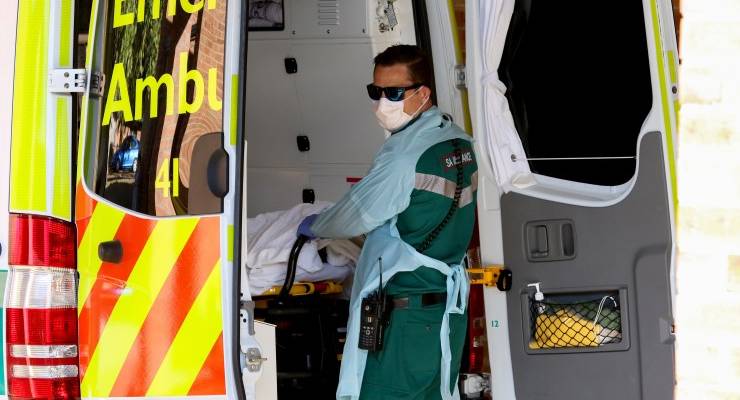
COVID-19 doesn’t care. It doesn’t care whether you’re young and healthy, or that you washed your hands, stayed at home, and did everything right. It can still get you.

By now, the early signs are well-documented: a dry, hacking cough, a temperature, body chills, fatigue.
But when you suspect you have the coronavirus, even the process of getting tested is unpleasant. It involves someone in full protective gear sticking a swab very far up your nose.
For some people, COVID-19 is mercifully mild — a bit of a sore throat, headache and tiredness. If you had a mild case three weeks ago, you might’ve been tempted to pen a thinkpiece telling people to cool the hysteria.
In hindsight, that was maybe not the best idea.
For other normally healthy younger people, symptoms can develop with alarming speed and severity.
“I woke up with a little scratch in my throat and started trying to cough it up,” one Canadian woman said.
“Within 20 minutes I had a full-blown fever, I was hacking up my lungs and it hit me: I need help.”
You lose your sense of smell and taste — “a kind of sensory quarantine.”
You cough, and cough, and when you can’t cough anymore, it gets impossible to breath.
There’s a real arbitrariness defining COVID-19. We don’t know why some people get such mild cases, or why otherwise healthy people end up in ICU.
Others say having the virus didn’t feel linear — things seemed to be getting better, until suddenly, they weren’t.
And for loved ones looking after you at home from a distance it’s a horrendous time — sleepless nights, late-night calls to the doctor, the constant fear you’ve made the wrong choices.
About 20% of cases require hospitalisation, with 5% needing the ICU.
Still, if you can be looked after at home, no matter how bad your symptoms seem, you’re classified as having a “mild” case of COVID-19 — one that doesn’t require hospitalisation or a stretch in the ICU.
Age won’t save you from needing a hospital bed. As one 26-year-old New Yorker wrote: “The hospital staff told me that more and more patients my age were showing up at the ER.
“Our invulnerability to this disease is a myth — one I have experienced firsthand. “
For a more serious case, where your lungs have become inflamed and filled with fluid, you’ll end up in the ICU. There, you might be given a dose of humidified oxygen. If things don’t get better you’ll be intubated — a tube is put down your windpipe and fed oxygen from a ventilator, allowing you to breathe.
A serious case of COVID-19 is a long slog. People admitted to ICU spend an average of 10 days there.
If you’re in Australia, you’re one of the luckier ones. Our health system isn’t falling apart under the sheer weight of new cases — yet. If we keep socially distancing, we can hopefully avoid the fate of other countries.
Elsewhere, it’s beginning to look a lot like a war. The images could be from Bergamo or Wuhan, Madrid or London.
In New York, they’re using tents as field hospitals in Central Park.
If you’re a doctor or nurse on the front line in any of the worst affected areas, every day is a horror movie.
As sick people start to outnumber ventilators, you might have to decide who gets oxygen. You have to be there when patients die. When they die of COVID-19, they die alone.
You might end up having to intubate your own colleagues. As a healthcare worker, you’re particularly vulnerable to getting infected.
We don’t really know how long it takes to recover from a more severe case of COVID-19

If you were on a ventilator, it may be months until you regain full lung function. If you had a severe case, you may have developed acute respiratory distress syndrome (ARDS), where fluid collects in the air sacs in your lungs. Many patients with ARDS suffer long-term respiratory damage.
A study of the first wave of patients discharged from a hospital in Hong Kong found many had 20-30% reduced lung capacity. They could barely walk without gasping for breath.
All of this sounds awful, but it can be avoided. Stay home, wash your hands, and be safe.














Kishor, you left out the best line from Shiraz Maher’s blog:
“Someone replying to my thread described it as having “shards of glass in your lungs.” That’s an accurate description.”
It is clinically referred to as ‘glass’ and fills both lungs up to destroy any hope of the necessary gas exchange. Good piece, first hand accounts needed.
The first sentence of the article says the virus doesn’t care if you stay at home; the last sentence says stay at home and be safe. Which is it?
It says stay at home, and be safe. It doesn’t say say at home and you will be safe. More of a wish than an instruction
Not underestimating Covid 19, but the swab is a forking doddle. Had one when I had whooping cough not long ago. If that’s painful, wait till you get to the serious shite.
The swab is a doddle, if you think that’s painful, see a doctor, and get a spline transplant.
Each countries response will be dictated by the human and material resources available to deal with the pandemic. That’s why testing regimes differ so much between countries as a for instance.